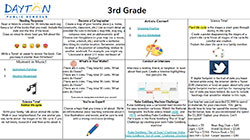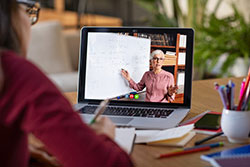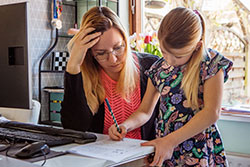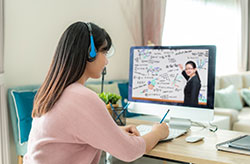Redefining Learning, Reinventing Schooling: Ohio Educators Pull Together to Embrace Students and Families During Pandemic

“On March 12, 2020, Ohio Governor Mike DeWine ordered all Ohio school districts, community schools, and private K-12 school buildings to close, effective at the end of the school day on March 16, for what was initially dubbed an “extended spring break.” The order was subsequently extended through the end of April and again for the remainder of the 2019-2020 school year in order to reduce the spread of COVID-19.
“Within three days, we basically came up with a plan to use for the first three weeks in which the governor closed our buildings…but we figured that school would be closed longer than those three weeks,” said Dr. Ron Iarussi, Superintendent of the Marion City Schools. “We have about 4,500 students in the district and we’re 100% free and reduced lunch,” added Iarussi. In addition to providing 2,000 Chromebooks to families in Marion, the district is partnering with businesses to ease restrictions to Wi-Fi and considering how to deliver hotspots to families.
The Governor’s directive challenged Marion and every other district in the state to very quickly develop a plan for meeting the academic and social-emotional needs of all students through remote-learning formats. It required extraordinary effort and unprecedented levels of collaboration, adaptability, and ingenuity. It also led to a new – or renewed – appreciation for the work that teachers, administrators, related services personnel, and school staff do every day to support meaningful learning for Ohio’s 1.7 million children and youth.
Maximizing Engagement in Learning
Ohio educators are using a variety of approaches to support student learning and minimize the loss of previously acquired knowledge and skills. Regardless of the virtual platforms used – whether they be Zoom, Google Classroom, WebEx, or something else – district leaders are most concerned about issues related to access to learning and ways to care for the physical and social-emotional needs of all children and their families.
Access issue #1: Providing devices and internet access. “The biggest challenge, far and away, is access,” stated Dr. Josh Englehart, Superintendent of the Painesville City Local School District in northeastern Ohio Lake County. Like many other districts, Painesville City Local provides Chromebook computers to students, but kept those computers at the schools. “It wasn’t as easy as just opening the school up one day and having the kids come in and pick up their devices and go home. We had to catalogue and inventory, and set up a system for signing all those computers out, and have distributed over 1,200 Chromebooks through that process,” he said.

Having a Chromebook or another device is only one component of ensuring access to learning. Having access to reliable internet service is a bigger challenge for many families. “It has taken a lot of effort just to get our families connected up; here, in the early stages, that’s been the biggest challenge,” said Englehart.
In Ohio’s largest district, leaders are working to address similar issues on behalf of 50,000 Columbus City Schools students. “The biggest challenge is definitely access,” said Dr. Angela Chapman, Chief of Transformation and Leadership. According to Chapman, about 18,000 Chromebooks have been distributed and the district is boosting Wi-Fi in all schools across the district “so families can come to the schools, sit in the parking lot, playground, or surrounding areas, and access those drops if needed.” “We currently have 500 hotspots to give out and we just ordered 1,000 more so families have internet access,” she said.

Dayton Public Schools (DPS) Superintendent Dr. Elizabeth Lolli also regards providing devices and Wi-Fi to families as the biggest challenge being faced by the district. “Wi-Fi should really be a public utility, like electricity and water in this day and age,” said Lolli. DPS has equipped school buses with Wi-Fi and is sending them into neighborhoods using a published schedule so families know when a bus will be in their area. Chromebooks and hotspots were initially distributed to seniors, and the district is distributing a donation of 1,200 phones that can be used as hotspots to juniors first and then sophomores. “Ours has been an equity issue with Wi-Fi and devices,” Lolli said.
Access issue #2: Supporting students to learn remotely. In Canton City Schools, the district’s leadership team identified expectations for remote learning, defining it simply as learning that occurs when there’s time and space in between the learner and the teacher or the information. “Once we made sure everyone understood what remote learning meant, we got into some general do’s and don’ts,” said Director of Curriculum Kim Kingsbury.

Choice boards (see sample above), work packets, and other resources have been developed by DPS and are being used to ensure that learning continues. Students in DPS select activities from the choice board for their grade level or by content area and are encouraged to review their selections with an adult or older sibling and complete two activities per day. New choice boards are developed and made available weekly, and teachers incorporate choice board activities into weekly lesson plans. DPS also makes available guidance for providing support and making accommodations for students who need them. Distance learning is supported through the district-run TV station.
In Columbus City Schools, different platforms for every subject/content area, as well as every elective course were identified and are being used, according to Dr. Tracy Ocasio, Chief Academic Officer for the district. “This self-paced platform is the floor; we’ve asked teachers to augment those lessons so that students get what they need, whether they’re behind, working a little below grade level or there are gap skills that are helping or hindering them from mastering grade-level content in a particular area, or if they are advanced and need extensions or enrichment,” explained Ocasio.

Ocasio, like other district leaders, believes that helping students to engage in online learning can be challenging. “We’ve been able to overcome the access to a device, and the access to Wi-Fi, but it’s also about motivating students to do something differently. It may be that students that were motivated in a traditional setting aren’t motivated in an online setting. Or, it may be that students just aren’t accustomed to learning this way and it’s not really something that fits them. So, we’re finding challenges with helping students be engaged.”
“Everybody’s trying to access what they can online and that’s been difficult. I’ve heard from parents that yeah they might have one computer at home, but they have four kids. I think the most important thing, what we’ve learned is we have to find a way to get feedback from our families about what’s happening and what’s not so we’ve been releasing a communication every day,” said Iarussi.
In Canton, “…every family in the district, every two weeks, is getting a personal phone call from someone that they’re connected to in that school, whether it’s the classroom teacher or the principal. And we have questions that we’re asking just to touch base, see how it’s going, see what they might need, catch anyone who needs technology that we didn’t know about already, and really just to make sure people are ok,” said Kingsbury.
"Our biggest success... is the engagement on the part of the families and students. That's really exciting to us. It sort of smashes this myth that our kids won't engage or that our families won't engage."
Josh Englehart, EdS, PhD, Superintendent
Painesville City Local Schools
Similarly, in Dayton, teachers “…make individual contact with a student at least once a week to make sure they don’t have any questions or any concerns and make sure that the parents also are involved in that process,” explained Lolli.
Painesville City Local, like other districts, regularly communicates with families in the district to alleviate anxiety associated with learning to use online platforms, troubleshoot issues, and make sure students are continuing to learn. “Our biggest success here in the earlier stages I would point to is the engagement on the part of the families and students. We have between ninety and ninety-four percent of students at each building who have accessed the platform. That’s really exciting to us. It sort of smashes this myth that our kids won’t engage or that our families won’t engage,” shared Englehart.

Access issue #3: Supporting faculty and staff to work remotely. Shifting to an all-online instructional delivery format was uncharted territory for many districts, requiring educators to learn new skills at a rapid pace. In northeast Ohio, the Mahoning County Educational Service Center (MCESC) is working hard to provide support to teachers, administrators, related services personnel, and others in 35 districts in Mahoning, Trumbull, Columbiana, and neighboring counties.
“We had to pivot and provide in the very short time that we’ve been in this situation K-12 lessons and units for our teachers in English/language arts, math, science, and social studies,” explained John Kuzma, Director of Teaching and Learning for MCESC. “We developed and are continuing to develop lessons based on three tenets…easily understood by parents, engaging for students, and easy for teachers to implement,” added Kuzma.
Kuzma’s department holds virtual office hours for teachers to discuss lesson plans and seek assistance on how to teach in an online environment, continues to provide professional development online, holds administrative-level meetings with principals and curriculum directors, and has created a support network for helping educators adapt to using Google Classroom and other online tools. Kuzma works closely with MCESC Superintendent Traci Hostetler, Andrew Velchek, Director of Technology for MCESC, and Dr. Kim Monachino, MCESC’s Director of Early Childhood and Pupil Services.

Monachino oversees preschool services and related services such as occupational therapy, speech-language pathology services, and more. Therapists are working virtually with children one-on-one. Teachers are creating instructional videos, game boards, and a variety of other resources to address individualized academic and behavioral goals. “Collaboration has really been tremendous during this time. Teachers are pulling together and sharing and trying to do the best with what we have…at the heart of what we do is caring for children and teaching children,” said Monachino.
“There’s a lot of hands-on when you’re looking at speech and OT and PT and that’s not counting the 70 or so preschool and special education classrooms throughout the counties…,” explained Velchek whose two-person department provides tech support for everything from web cams that don’t work to supporting people to use Zoom and Google Classroom, to facilitating virtual board meetings and related activities. “As you can imagine, this is a shift of every part of what we do,” he reflected.
Professional learning for teachers and other educators in Canton took the form of ed camps. “We did a lot of professional development for teachers and just finished our second ed camp. We had 45-minute timeslots all throughout the day on a variety of topics. So if you needed to learn about how to do a Google Meet, there was an ed camp for that; if you needed to learn how to use your Pearson math curriculum online, there was an ed camp for that. And then teachers could choose which one they wanted to attend and it was our own staff presenting the information,” explained Kingsbury.
In Youngstown, a comprehensive professional development (PD) program was quickly developed to maintain the momentum around the district’s focus on literacy instruction grounded in the science of reading. “We had 19 sessions the first week…they were live in partnership with the state literacy leads and also through our state support team,” explained Christine Sawicki, Chief Academic Officer for the Youngstown City School District.
A second round of PD comprised of 32 sessions aligned with the district’s goals in literacy and math was released and the district technology department is offering sessions in topics like how to create and run a Zoom meeting. All sessions are recorded so staff members can access the content, and to be used in building an onboarding process for new staff. “We’ve kept our focus and everybody’s moving in the same direction and everybody sees that,” said Sawicki.

Gianna Rohan, who teaches Geometry and Algebra 2 for Sough Range High School (South Range Local School District in Canfield) is using a variety of tools and formats in creative ways to keep students engaged in learning.
Google Forms are used for students to complete, like homework. Rohan is using FlipGrid to post prompts in response to which students create videos, and testing the use of DeckToys to turn worksheets or problems into virtual escape rooms or virtual games. Since the district cancelled spring break, Rohan surveyed students to find out where they would like to go on spring break and then used YouTube videos to “travel” to various locales (e.g., Hawaii). She developed math problems associated with the locations (e.g., beaches in Hawaii).
“One of the things I told my students from the beginning is that we need to view this as a learning opportunity,” said Rohan. “My biggest challenge is that I don’t have the ability to have an immediate conversation with them…to go through a problem-solving process…where I can assess them immediately and give them feedback. But, different things that I’ve been trying to use have kind of helped me overcome that.”
Addressing Inequity

The Annie E. Casey Foundation reported in 2019 that 20% – over a half million – of Ohio’s children under the age of 18 lived in poverty. According to Children’s Defense Fund-Ohio, over 50% of Ohio’s school children were categorized as economically disadvantaged – defined by the Ohio Department of Education as the percent of students in poverty in school districts. In some Ohio districts, like Marion City, 100% of the student population is eligible for free and reduced price meals.
“We know our students rely on us to feed them and that was one of our major concerns when schools were closed. Our number one priority was to make sure we were really trying to take care of all the social-emotional needs of our families,” said Iarussi.
Wednesdays are what Marion calls food service days. “We’ve fed about 3,000 of our 4,500 students. This time at home is not good for many of our students…some come from traumatic home-life experiences…and many have issues with mobility and where they’re staying on a regular basis. In the first three weeks, we had no contact with a little over 400 of our students, which was a huge concern. We’ve narrowed that number down to about 80, which is still a concern. At times like this, I think it really has showcased the inequities that exist amongst our different school districts,” he added.
Like Iarussi, Painesville district leaders see equity issues to be at the heart of what needs to be addressed going forward. “I’m hoping that this whole closure really brings back to center discussions about inequity and access issues. You know you can’t have serious discussions about our educational system overall without placing issues of access and equity at the center and I think this has become another example of how these inequities operate within our system,” said Englehart.
In Ohio’s larger urban districts, making sure children had access to food was also a priority. “It’s a high point that the community has pulled together the way that it has to support students in Dayton Public Schools,” said Lolli. “We’ve given out over 250,000 meals in the last five weeks. We have a variety of organizations that donated backpacks and school supplies when we initially started the feeding program that we were able to give out to families that came to get their food, and then also deliver to the families that could not come because they don’t have transportation,” she said. DPS is partnering with the Regional Transit Authority to pick parents up at no cost from certain locations in the city, take them to food distribution sites, and return them home. Canton’s catchphrases for alleviating stress and attending to the physical and social-emotional needs of children and families is “less is more” and “Maslow before Bloom.” “We have to take care of our families before we even think about academics…we can’t lose sight of the potential for the traumatic experiences that kids are going through, and keeping that connection with their teacher and their friends is so important,” stated Kingsbury.
Youngstown’s Sawicki shares a similar sentiment. “I just think that really wanting to make sure that everybody is safe and healthy is our number one concern and that’s top priority. Everything else is secondary.”

In Columbus, Chapman describes the district’s commitment to “embracing our students and thinking outside the box, and going above and beyond for our students during this time” as a high point evident in the actions of Columbus City School staff. “We have data from the online platforms and our usage is about 50 percent, so 50 percent of our students are logging on and using online resources. We have lots of questions about the other 50 percent…that certainly keep us up at night,” she said.
Preparing for the New Normal
If there’s a silver lining in what districts have had to do in responding to the pandemic-related closure, it’s the relationships that have been forged – among educators within and across districts and between districts and their wider school communities. “The relationships that have been built amongst our staff member and our students, that to me is a bright spot. Parents are talking about how their kids just miss their teachers so much and…our teachers talk about how much they miss the face-to-face interaction with the kids; it’s truly incredible,” shared Iarussi.
“I’ve watched teams across departments come together and collaborate to meet the problems of practice, having students being able to continuously learn,” offered Ocasio. Chapman cites the resiliency of Columbus City Schools students as a major success factor. “We recognize and appreciate everyone’s efforts for not throwing in the towel, not giving up, and staying the course.”

Kingsbury also cites the relationships that are being built as one of the major successes resulting from the forced closure. “I think it’s really important that we’re making relationships to people that maybe we haven’t touched in that way before. And, I think it’s going to carry us through, even outside of this remote learning time; it’s going to really serve us well.”
District and ESC leaders see other changes on the horizon. “I think as we continue to work through this virus and people get more accustomed to online learning, that there will be parents who actually request to home educate their students through the public school systems…I think you’re going to see online learning departments open up in the future…because of the requests, in my estimation, that are going to come from parents,” said Lolli. Englehart agrees: “I think that online learning can really become a legitimate option to punctuate traditional instruction. I also believe that we, as a district, and districts in general are going to be better positioned to continue down the road of going paperless not only with curriculum and instruction but with other processes too…which offer all kinds of operational efficiencies and cost savings.”

However, Englehart doesn’t see online learning completely replacing face-to-face delivery of instruction. “No matter how well it’s done, I think there are still limitations to online frameworks. I hope I don’t see more person-to-person traditional instruction get squeezed out by remote learning.
As an ESC Superintendent, Hostetler observes what’s happening in multiple districts in her area of the state. “I think this will transform the way we do things in the future. We’ll be able to reach more people…help kids who maybe have illnesses where they’re more susceptible and can’t come out. We can serve them better now remotely. So I think in a lot of different ways, we were pulled out of the Dark Ages by this happening…if there’s a silver lining, I think that’s it. Another silver lining is that we’ve discovered that teachers are really important. For the first time in my entire life, I’m hearing kids say, ‘I want to go back to school! I miss my teachers, I miss my classmates.’ I don’t remember parents saying ‘I love my school!’”
But, like Englehart, Hostetler feels important aspects of traditional instruction are not possible in remote formats. “We are missing some significant components right now. The collaboration, the ability to problem-solve and think critically because others are around, the hand-on, the face-to-face.”
Educators are also contemplating what fall 2020 will look like give the need to practice social distancing and taking other precautions to keep students and staff safe. “It’s hard to keep students six inches apart, let along six feet. That’s just the nature of children. We’re going to have a new way of doing school. We may have to have staggered scheduled…alternate structures; we may have to deliver content differently. Blended learning may be even more important than it had been in the past. Twenty-first century skills are going to be necessary,” articulated Ocasio. “This crisis and this pandemic has caused us to think differently…and thinking about returning to school, what are other Ohio districts doing to plan for that…how do we create our own professional learning community around figuring it out,?” posited Chapman.
Iarussi focuses discussion around ‘what’s next’ on what teaching and learning are all about: “we’re going to be a lot more in tune with what individual children need. It brings us to the realization that we have to build the way we educate around our students.”
References
The Annie E. Casey Foundation. (2019). 2019 Kids count data book. Baltimore, MD: Author. Retrieved from www.aecf.org.
Remote learning resources guide: During the coronavirus pandemic ordered school-building closure. Columbus, OH: Ohio Department of Education. Retrieved from http://education.ohio.gov/getattachment/Topics/Student-Supports/Coronavirus/Remote-Learning-Resource-Guide.pdf.aspx?lang=en-US
For More Information
Sincere thanks are extended to the educators who shared strategies for maintaining and extending learning during the pandemic. Watch for OLAC podcasts coming soon that will feature the educators referenced in this issue of Cornerstone Connections!
Angela Chapman, EdD, Chief of Transformation and Leadership, Columbus City Schools, achapman@columbus.k12.oh.us
Josh Englehart, EdS, PhD, Superintendent, Painesville City Local Schools, josh.englehart@pcls.net
Traci Hostetler, Superintendent, Mahoning County ESC, t.hostetler@MahoningESC.org
Ron Iarussi, EdD, Superintendent, Marion City Schools, riarussi@mcspresidents.org
John Kuzma, Director of Teaching and Learning, Mahoning County ESC, J.Kuzma@MahoningESC.org
Kim Kingsbury, Director of Curriculum, Canton City Schools, kingsbury_k@ccsdistrict.org
Elizabeth Lolli, PhD, Superintendent, Dayton Public Schools, EJLOLLI@DAYTONPUBLIC.COM
Kim Monachino, EdD, Director of Early Childhood and Pupil Services, Mahoning County ESC, k.monachino@mahoningesc.org
Tracy Ocasio, EdD, Chief Academic Officer, Columbus City Schools, tocasio@columbus.k12.oh.us
Christine Sawicki, Chief Academic Officer, Youngstown City Schools, christine.sawicki@youngstown.k12.oh.us
Andrew Velchek, Director of Technology, Mahoning County ESC, a.velchek@mahoningesc.org
For more information about resources to support districts during the pandemic and beyond, contact Dr. Jim Gay, OLAC Co-director, at jimgay@basa-ohio.org; or Karel Oxley, OLAC Co-director, at Oxley@basa-ohio.org.
This article was written for OLAC by Deborah M. Telfer, PhD, Director & Research Associate, University of Cincinnati (UC) Systems Development & Improvement Center, in collaboration with WordFarmers Associates. The UC Systems Development & Improvement Center is a center within UC’s College of Education, Criminal Justice, and Human Services.